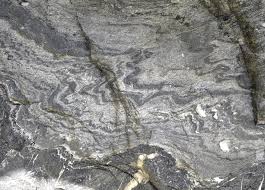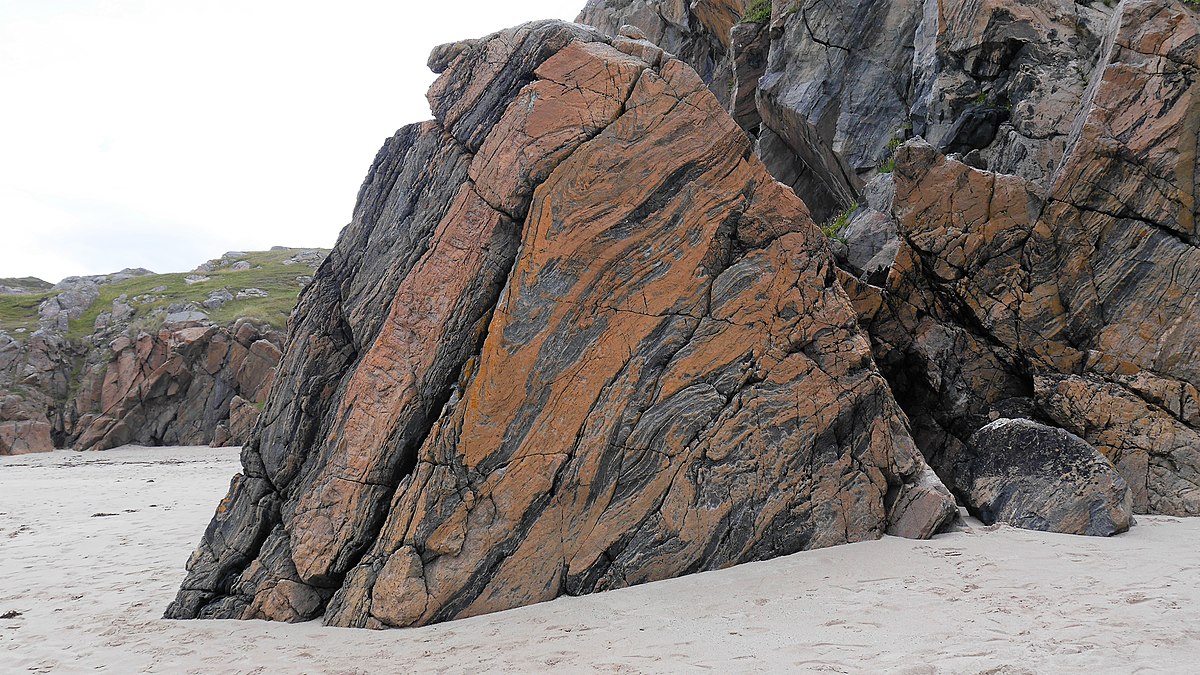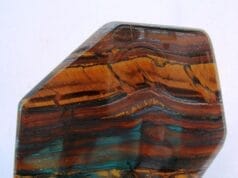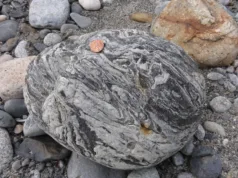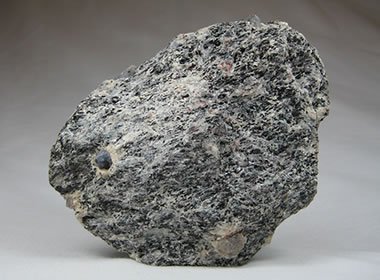

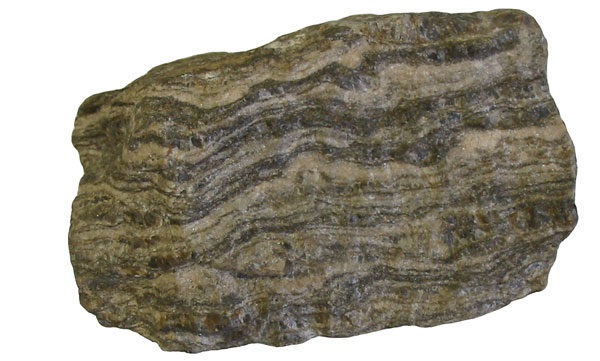
Gneiss is a foliated metamorphic rock that is a common distribute type of rock high-grade regional metamorphic approaches from pre-current formations that have been initially both igneous or sedimentary rocks. It has a glorious banding which is apparent on microscopic scale and hand specimen. It usually is prominent from schist by its foliation and schistosity; displays a properly-advanced foliation and a poorly advanced schistosity and cleavage
Name origin: Gneiss word first has been used English since at least 1757. Probably origin is german word Gneis that mean “spark” (rock glitters).
Parent Rock: Shale, granitic and volcanic rocks
Texture: Foliated, foliation on a scale of cm or more.
Grain size: Medium to coarse grained; seeing with the naked eye.
Hardness: Hard.
Colour: generally alternating lighter and darker sub-parallel discontinuous bands.
Mineralogy: Felsic minerals such as feldspar ( orthoclase, plagioclase) and quartz generally form the light coloured bands; mafic minerals such as biotite, pyroxene ( augite) and amphibole ( hornblende) generally form the dark coloured bands; garnet porphyroblasts common.
Other features: Generally rough to touch.
Structure: In addition to the gneissose texture described above, gneisses tend to be banded on a large scale with layers and streaks of darker and lighter coloured gneiss. Granite and quartz veins and pegmatites are common. May be folded.
Classification and Types of Gneiss
The Gneiss minerals are order into layer that seeing as band. Those layers are compositional banding, happens due to the fact the layers, or bands, are of different composition. The darker bands have incredibly extra mafic minerals (the ones containing more magnesium and iron). The lighter bands incorporate fantastically extra felsic minerals (silicate minerals, containing more of the lighter elements, which include silicon, oxygen, aluminium, sodium, and potassium).
Augen gneiss
Augen gneiss, from the German: Augen , which means “eyes”, is a coarse-grained gneiss because of metamorphism of granite, which incorporates characteristic elliptic or lenticular shear-bound feldspar porphyroclasts, typically microcline, within the layering of the quartz, biotite and magnetite bands.
Henderson gneiss
Henderson gneiss is found in North Carolina and South Carolina, US, east of the Brevard Shear Zone. It has deformed into two sequential forms. The second, more warped, form is associated with the Brevard Fault, and the first deformation results from displacement to the southwest.
Lewisian gneiss
Most of the Outer Hebrides of Scotland have a bedrock formed from Lewisian gneiss. In addition to the Outer Hebrides, they form basement deposits on the Scottish mainland west of the Moine Thrust and on the islands of Coll and Tiree. These rocks are largely igneous in origin, mixed with metamorphosed marble, quartzite and mica schist with later intrusions of basaltic dikes and granite magma.
Archean and Proterozoic gneiss
Gneisses of Archean and Proterozoic age occur in the Baltic Shield.
Chemical Composition of Gneiss
Gneissic rocks are usually medium- to coarse-foliated; they are largely recrystallized but do no longer deliver large quantities of micas, chlorite or different platy minerals. Gneisses which can be metamorphosed igneous rocks or their equivalent are termed granite gneisses, diorite gneisses, and so on. Rhey can also be named after a characteristic component inclusive of garnet gneiss, biotite gneiss, albite gneiss, and many others. Orthogneiss designates a gneiss derived from an igneous rock, and paragneiss is one from a sedimentary rock.
Gneiss Formation
All gneiss forms as a result of high-grade, regional metamorphic conditions. High grade means that the metamorphism occurs at high pressures and at temperatures at or above 320 degrees Celsius. Any water that is present in the minerals pre-metamorphism is frequently lost as the temperature increases, resulting in hard metamorphic rocks that are generally resistant to dissolution in water. Regional means that the metamorphic conditions occur over large geographic areas and include differential (or shearing) stresses, which help to form the layered structure known as foliation. Gneiss rocks exhibit a unique form of foliation known as gneissic banding, which are thicker bands of foliation than most metamorphic rocks display. It is one of the features that helps differentiate gneiss from other foliated rocks. Mineralogically, tends to include quartz, feldspar, mica, chlorite, and other clay minerals. Some also contain larger crystals imbedded in the rock matrix, most frequently garnet, topaz, and beryl minerals.
Where is it found
Gneiss, being a highly deformed crystalline metamorphic rock, is commonly found in the cores of mountain ranges and in Precambrian crystalline terranes. The rock itself is formed at crustal depths of 10 to 20 km, at pressures of 10kb or more, and temperatures between about 500-700°K, so at depths where rock becomes quasi-viscous, high-grade minerals such as biotite and garnet form that lend a characteristic foliation or banding, but just below temperatures where quartz and feldspar and muscovite begin to melt and/or break down and form veins of granite. There are many varieties of it, depending on mineral composition and texture, but all gneiss is evidence of deep crustal deformation. Study of gneiss is an important part of metamorphic petrology.
Gneiss Uses
Gneiss usually does not break up alongside planes of weak point like maximum other metamorphic rocks. This allows contractors to apply as a overwhelmed stone in road production, building web site guidance, and landscaping tasks
It is long lasting sufficient to carry out properly as a size stone. These rocks are sawn or sheared into blocks and slabs utilized in a ramification of constructing, paving, and curbing initiatives.
Some of it accepts a vibrant polish and is appealing sufficient to be used as an architectural stone. Beautiful floor tiles, facing stone, stair treads, window sills, counter tops, and cemetery monuments are regularly crafted from polished gneiss.
Conclusion
- It is distinctive among other rocks that have bands because its minerals are not evenly distributed so the bands are various widths.
- Under appropriate conditions, it can be recrystallized into granite.
- There is gneiss in Canada that date back 4 billion years.
- It is so abundant on the lower level of the Earth’s crust that if you drill anywhere on the surface, you will eventually strike gneiss.
- It is said to be a German word meaning sparkling or bright.
- The rock is further characterized by its alternating light and dark bands of minerals.
- It forms from volcanic rock, shale, or granitic.
- Quartz is typically abundantly found in gneiss.
- The bands that form on gneiss rock are due to the various rocks that are a part of its make-up.
- The use of the word gneiss dates back to the mid-1700s.
- It rocks that originate as sedimentary rock are called paragneiss and those originating as igneous rock are called orthogneiss.
- Limestone can change into calcareous gneiss which contains calcium carbonate.
- Gneiss and schist are often confused but gneiss has more of a coarse texture and does not cleave.
- Some of the oldest rocks found on Earth are gneisses.
- It has also been used to construct buildings and gravestones.
References
- Bonewitz, R. (2012). Rocks and minerals. 2nd ed. London: DK Publishing.
- Atlas-hornin.sk. (2019). Atlas of magmatic rocks. [online] Available at: http://www.atlas-hornin.sk/en/home [Accessed 13 Mar. 2019].
- http://www.softschools.com/facts/geology/gneiss_facts/381/
- “Gneiss.” World of Earth Science. . Retrieved April 06, 2019 from Encyclopedia.com: https://www.encyclopedia.com/science/encyclopedias-almanacs-transcripts-and-maps/gneiss
- Gneiss. (2017, June 23). New World Encyclopedia, . Retrieved 16:44, April 10, 2019 from http://www.newworldencyclopedia.org/p/index.php?title=Gneiss&oldid=1005304.
- Wikipedia contributors. (2019, March 3). Gneiss. In Wikipedia, The Free Encyclopedia. Retrieved 16:44, April 10, 2019, from https://en.wikipedia.org/w/index.php?title=Gneiss&oldid=885997457



























